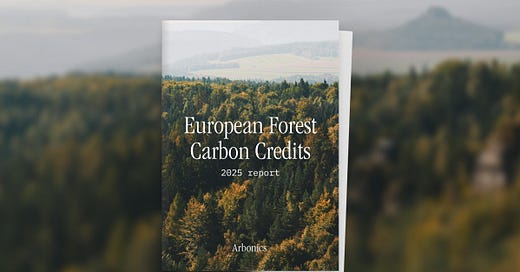European Forest Carbon Credits 2025 report
A 30-page report covering the latest standards, market dynamics, pricing, and the key credit buyers and project developers.
Welcome back to Arbonics, where we explore the evolving landscape of forestry, voluntary carbon markets, and climate solutions more broadly.
Today, we'd love to share our European Forest Carbon Credits 2025 report (download your copy here).
In the span of just five years, we’ve seen a significant shift in the global voluntary carbon market. Demand has not only grown — it has evolved and matured. Buyers have moved beyond volume-based offsetting. The focus today is on quality, transparency, and impact.
Large corporate investors in carbon removal are looking deeper: how are the credits generated? What evidence supports the project’s claims? What social and ecological impacts does it deliver beyond carbon removal?
This shift is reshaping both demand and supply. While interest remains strong, the types of credits being sought are changing. Older methodologies are gradually being retired, while a new generation of high-integrity projects is only beginning to scale.
As a result, price pressure is mounting across the highest-quality segments of the market.
Today, supply is no longer keeping pace with demand, especially for removal-based credits that meet rigorous standards.
European forest carbon projects offer valuable diversification within the voluntary carbon market.
Strong legal frameworks, established land governance systems, and growing policy alignment have laid the foundation for high-integrity projects that not only remove carbon, but also restore ecosystems and support rural economies at scale.
However, clarity is still lacking. Buyers navigating forest carbon encounter a patchwork of standards, a limited supply of high-integrity removal-based credits, and an ever-evolving list of regulatory requirements
Understanding which carbon projects deliver real, lasting impact — and which ones do not — is more important than ever.
Our report offers the latest insights into the European forest carbon market.
It delineates the 2025 standards of how forest carbon credits are generated and verified, as well as how developers approach permanence, leakage, and social integrity.
It explores how methodologies might differ, how prices are calculated, and why timing matters in a market where supply lags behind demand.
Finally, it provides a clear path for companies looking to invest in high-integrity forest carbon projects.
So, whether you're assessing projects for the first time or refining an existing strategy, we hope this report serves as a practical guide.



